Thrombolysis
Medically reviewed by Drugs.com. Last updated on Sep 23, 2025.
AMBULATORY CARE:
What you need to know about thrombolysis:
Thrombolysis is a procedure to dissolve or break up a blood clot. A blood clot can block blood flow to areas of your body and become life-threatening. Thrombolysis can return blood flow and reduce harm to areas such as your brain, heart, or lungs.
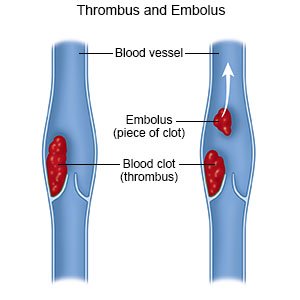 |
How to prepare for the procedure:
- Your healthcare provider will tell you how to prepare. Your provider may tell you not to eat or drink anything after midnight on the day of your procedure. Arrange to have someone drive you home after you are discharged.
- Tell your provider about all your current medicines. Your provider will tell you if you need to stop any medicine for the procedure, and when to stop. Your provider will tell you which medicines to take or not take on the day of the procedure.
- You may be given contrast liquid before or during the procedure to help your provider see the clot better. Tell the provider if you have ever had an allergic reaction to contrast liquid.
What will happen during the procedure:
- General anesthesia may be given to keep you asleep during the procedure.
- Your healthcare provider will inject medicine into your IV that will help dissolve or break up the clot. It is most commonly given into a vein, but it may be given into an artery. If the medicine is given into an artery, a catheter is guided by x-ray so it is near the blood clot.
- Your heart rate and blood pressure will be monitored. Healthcare providers may also frequently check your neurological (neuro) status. Your neuro status is checked to see how well your brain is working. Healthcare providers may check your eyes, your memory, and your hand grasp.
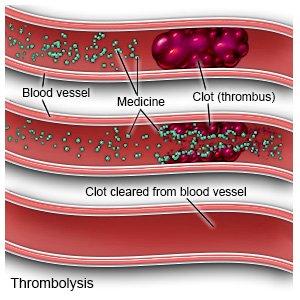 |
What to expect after the procedure:
You will be monitored closely for any problems. Do not get out of bed until your healthcare provider says it is okay. You will then be able to go home or be taken to your hospital room.
- The catheter may be left in place if the medicine needs to continue to break up the clot. You will need to stay in the hospital if the catheter is left in place. Your healthcare provider will need to do the thrombolysis again to remove the rest of the clot. You will be told not to move your leg while the catheter is in place. Tell your healthcare provider if lying flat starts to cause back discomfort. If there is no bleeding, your provider may help you roll onto your side.
- You will need to wear a compression device after your procedure. Examples include pressure stockings or boots and sequential compression devices. These improve blood flow and help prevent clots.
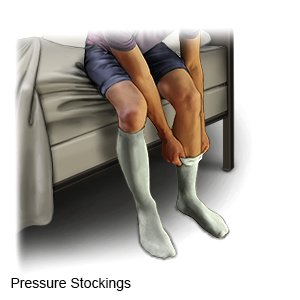
- You will be helped to walk around after the procedure. Movement will help prevent blood clots. You may also be given exercises to do in bed. Do not get out of bed on your own until your healthcare provider says you can. Ask before you get up the first time. You may need help to stand up safely. When you are able to get up on your own, sit or lie down right away if you feel weak or dizzy. Then press the call button to let someone know you need help.
- Medicines:
- Anticoagulants are a type of blood thinner medicine that helps prevent clots. Anticoagulants may cause you to bleed or bruise more easily.
- Antiplatelets help prevent blood clots. This medicine makes it more likely for you to bleed or bruise.
Risks of thrombolysis:
Thrombolysis increases your risk for bleeding. You may have increased nosebleeds or bleeding from your gums. You may also have bleeding in your stomach or brain. Bleeding can become severe and life-threatening.
Call your local emergency number (911 in the US) or have someone call if:
- You have any of the following signs of a heart attack:
- Squeezing, pressure, or pain in your chest
- You may also have any of the following:
- Discomfort or pain in your back, neck, jaw, stomach, or arm
- Shortness of breath
- Nausea or vomiting
- Lightheadedness or a sudden cold sweat
- You have any of the following signs of a stroke:
- Numbness or drooping on one side of your face
- Weakness in an arm or leg
- Confusion or difficulty speaking
- Dizziness, a severe headache, or vision loss
Seek care immediately if:
- Your arm or leg feels warm, tender, and painful. It may look swollen and red.
- Your procedure area does not stop bleeding even after you apply firm pressure for 10 minutes.
- The leg or arm used for your procedure is numb, painful, or changes color.
- The bruise at your catheter site gets bigger or becomes swollen.
- You have purple spots or blisters on your skin.
Call your doctor or hematologist if:
- You have a fever.
- You have a new skin rash and itching.
- You feel weak, lightheaded, or faint.
- You have new swelling around your eyes.
- You see blood in your urine.
- You have questions or concerns about your condition or care.
Related medications
Care for the procedure area as directed:
- Keep the area clean and dry, as directed. Ask your healthcare provider when you can bathe. You will need to keep the bandage in place and dry for a day or two after your procedure. Cover the bandage with a plastic bag and tape the opening around your skin to keep water out.
- When you can bathe without a bandage, carefully wash the area with soap and water. Dry the area and put on new, clean bandages as directed. Change your bandage if it gets wet or dirty.
- Check the procedure area daily for signs of infection. Examples include redness, swelling, or pus.
Watch for bleeding and bruising:
It is normal to have a bruise and soreness where the catheter went in. Contact your healthcare provider if your bruise gets larger. If your procedure area bleeds, use your hand to put pressure on the bandage. If you do not have a bandage, use a clean cloth to put pressure over and just above the puncture site. Seek care immediately if the bleeding does not stop within 10 minutes.
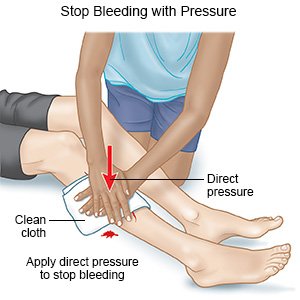 |
Wear a compression device as directed:
Examples include pressure stockings, intermittent pneumatic compression, and sequential compression devices. A compression device puts pressure on your lower legs to help keep blood from pooling in your leg veins. Your healthcare provider can prescribe the right device for you. Do not buy over-the-counter devices unless your provider says it is okay. They may not fit correctly or may have elastic that cuts off your circulation. Ask your provider when to start wearing a compression device and how long to wear it.
 |
Keep your leg elevated as directed:
Keep your leg above the level of your heart when you are sitting. Prop your leg on pillows to keep it elevated comfortably. Ask how long to keep your leg elevated each day. You will need to balance elevation with movement to prevent blood clots.
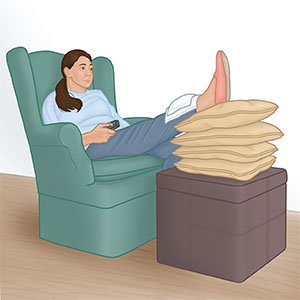 |
Do not lift anything heavier than 10 pounds
for 2 days after your procedure. For example, a gallon of milk weighs 8 pounds.
Do not strain when you have a bowel movement:
Straining may cause bleeding from your procedure area. Ask your healthcare provider if you need medicine to help make your bowel movements easier.
Prevent another blood clot:
- Do not smoke. Nicotine and other chemicals in cigarettes and cigars can cause blood vessel and lung damage. Ask your healthcare provider for information if you currently smoke and need help to quit. E-cigarettes or smokeless tobacco still contain nicotine. Talk to your provider before you use these products.
- Limit alcohol. Do not drink alcohol for 24 hours after your procedure. Then limit alcohol to 1 drink a day if you are female or 2 drinks a day if you are male. A drink is 12 ounces of beer, 5 ounces of wine, or 1½ ounces of liquor.
- Stay active. Your provider will tell you when it is safe to drive and start doing your other normal daily activities. An active lifestyle can help prevent blood clots. Try to get at least 30 minutes of activity on most days of the week. If you sit most of the day for work, stand or walk around every half hour. After a future injury or illness, try to become active again as soon as possible. Activity can also help you manage your weight.
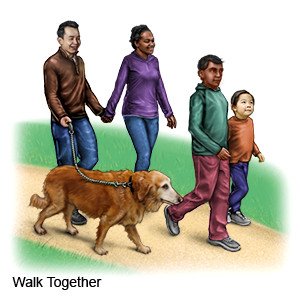
- Reach or maintain a healthy weight. Too much body weight can put pressure on your leg veins and cause blood to pool. This increases your risk for another blood clot. Ask your provider what a healthy weight is for you. Your provider can help you create a safe weight loss plan, if needed.
- Manage other health conditions. Follow your provider's directions to manage health conditions that can cause a blood clot. Examples are high cholesterol and diabetes.
- Drink liquids as directed. Liquid can help prevent blood clots. Ask your provider how much liquid to drink each day and which liquids are best for you.
Follow up with your doctor or hematologist as directed:
You may need to be checked for blood clots for up to 3 years after treatment. Write down your questions so you remember to ask them during your visits.
© Copyright Merative 2025 Information is for End User's use only and may not be sold, redistributed or otherwise used for commercial purposes.
The above information is an educational aid only. It is not intended as medical advice for individual conditions or treatments. Talk to your doctor, nurse or pharmacist before following any medical regimen to see if it is safe and effective for you.
Learn more about Thrombolysis
Care guides
Further information
Always consult your healthcare provider to ensure the information displayed on this page applies to your personal circumstances.
